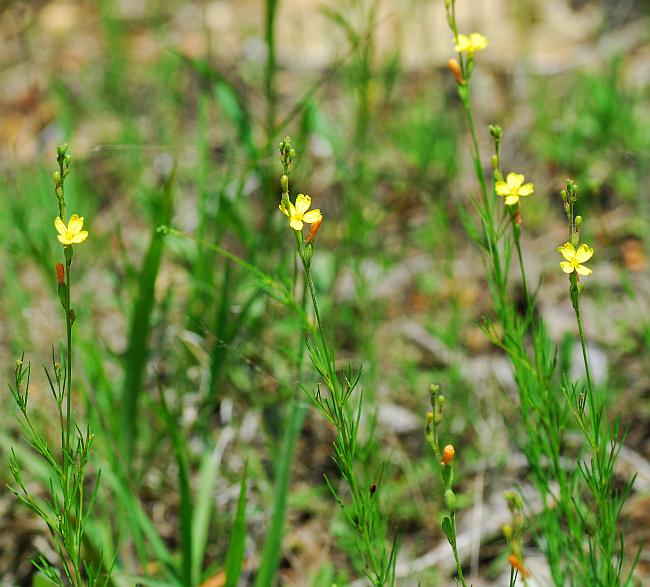Oenothera linifolia Nutt.
Sundrops

Native
CC = 4
CW = 5
MOC = 50
© SRTurner
Oenothera linifolia Nutt.Sundrops | |
 |
Native CC = 4 CW = 5 MOC = 50 |
© SRTurner |
|
Family - Onagraceae Habit - Taprooted annual forb. Stems - Erect, to 50 cm, solitary or few, unbranched or with few to many ascending branches, minutely nonglandular-hairy when young, sometimes also minutely glandular-hairy toward the tip, sometimes becoming glabrous or nearly so at maturity.
Leaves - Basal and alternate, the stem leaves also usually with axillary fascicles, the basal leaves sometimes withered at flowering; rosette leaves 1-2 cm long, 2-6 mm wide, ovate to spatulate, petiolate, the margins entire or with a few small teeth, also hairy, the surfaces glabrous or sparsely pubescent with short, appressed to curved, nonglandular hairs and/or minute, spreading, glandular hairs; stem leaves 1-4 cm long, 0.5-1.0 mm wide, linear to threadlike, sessile, the margins entire, the secondary veins not apparent.
Inflorescences - Open spikes, short to elongate, the axes sparsely to densely pubescent with short, appressed to upward-curved nonglandular hairs and/or minute, spreading glandular hairs. Bracts relatively inconspicuous, 0.5-2.0 mm long, 1-3 mm wide, ovate to ovate-triangular. Flowers sessile.
Flowers - Actinomorphic, opening at dusk and remaining open through the following day, the floral tube 1-2 mm long, sparsely hairy. Sepals 1.5-2.0 mm long, with short, spreading, glandular or nonglandular hairs, lacking free tips in bud. Petals 4, 3-5 mm long, 1-3 mm wide, obcordate to oblong-obovate, yellow, fading pink. Stamens 8, with the filaments 1-2 mm long, ascending or slightly incurved, glabrous at the base, the anthers 0.5-1.0 mm long, light yellow. Style 1-2 mm long, the stigma positioned at about the same level as the anthers, deeply 4-lobed, the lobes 0.5-1.0 mm long. Placentation axile. Ovules numerous.
Fruits - Capsules 4-6 mm long, the main body tardily longitudinally dehiscent toward the tip, 4-locular, 4-6 mm long, 1.5-3.0 mm in diameter, elliptic-rhomboid, not flattened, 4-ridged, the surfaces finely glandular-and/or nonglandular-hairy, sessile or rarely with a sterile, stout, stalklike base to 4 mm long, this also glandular- and/or nonglandular-hairy. Seeds numerous in each locule, clustered and not in definite rows, 0.9-1.4 mm long, 0.4-0.6 mm wide, irregularly rhombic-ellipsoid, the surface pale reddish brown, smooth to somewhat pebbled or minutely warty.
Flowering - April - July. Habitat - Glades, upland prairies, tops and ledges of bluffs, upland forest openings, savannas, pastures, cemeteries, railroads, and roadsides; usually on acidic substrates. Origin - Native to the U.S. Lookalikes - Species of Linum; distantly, Hypericum drummondii. Other info. - This delicate species is moderately common in the southern half of Missouri but rare or absent in most counties north of the Missouri River. Most of its U.S. distribution is within Missouri and five other states to our south and west. The plants are easily recognized by their slender, willowy stems with needlelike leaves, and yellow flowers above distinct, swollen ovaries. They look superficially similar to species of Linum, but those plants have five-petaled flowers with very different morphology. When not in flower, this species is inconspicuous and easily overlooked. The flowers do not last long and the species is often found in fruit. Photographs taken at Dave Rock Conservation Area, St. Clair County, MO., 6-16-05, and on Taum Sauk Mountain, MO., 6-1-03 (DETenaglia); also at Hughes Mountain Natural Area, Washington County, MO, 5-21-2012, and LaBarque Creek Conservation Area, Jefferson County, MO, 5-9-2017 (SRTurner). |